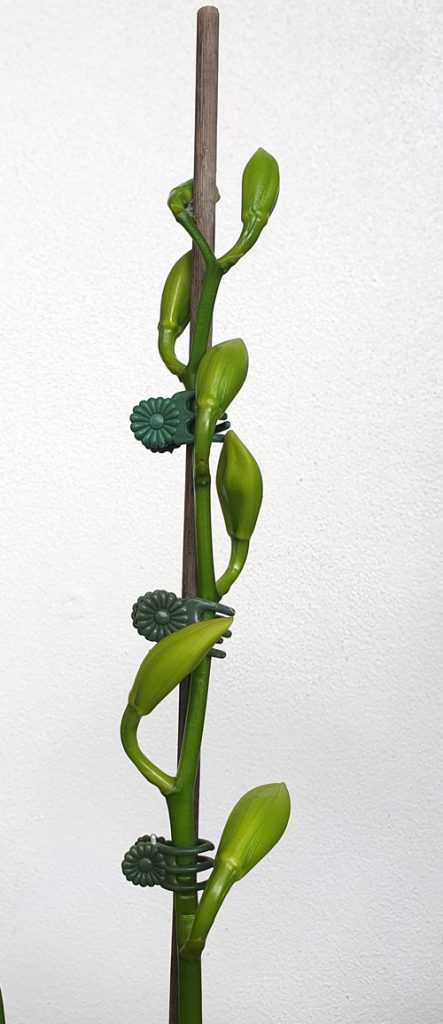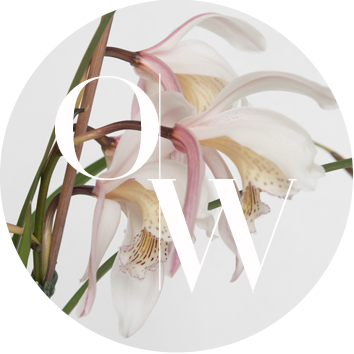Before Flowering
How do I look after my Cymbidium orchid flower spike?
Preparing plants coming into flower
Once your new Cymbidium orchid flower spike has appeared it is important to look after it well. There are lots of hazards ahead for it, and good attention to detail will pay big dividends.
The first challenge will be to confirm it is a spike and not a new lead growing. New spikes are quite round and come to a point at the top end. Whereas a new lead will be much flatter and will have a V shape on the top end.
Inserting a stake into the potting mix alongside each spike easily identifies where each flower spike is located. It can also act as protection for the spike, and enables early training. If you always know where the spike is, you will be extra careful not to break it as it is growing!
Be careful not to tie your Cymbidium orchid flower spike too firmly at this early time. Many spikes grow quickly, and if it is tied tightly to the support the spike will bend and sometimes they will break. Personally, I wouldn’t tie the stake firmly until the flower buds are out of the sheath. However, I do sometimes train spikes by very loosely tying them to the stake, but making sure the spike has room to move and grow. Check back every day or so to ensure the spike is still heading in the right direction and isn’t bending or breaking.
Watering
Many flower spikes start to appear during the hotter and drier periods of the season, towards the end of Summer. Make sure the plants are watered heavily in this time.
Your Cymbidium orchid should be watered sufficiently so that water starts running out of the bottom of the pot. In extreme temperatures, we sometimes also water for very short periods, every few of hours from noon till 6pm, to cool the plants. We water nearly every day during the very hot months, however, do check your pot carefully to ensure it really needs the water. Keeping your mix too wet will only rot the roots and kill your plant.
Foggers are also useful, which just produce a mist, and really don’t even wet the foliage, but provide a huge amount of cooling through humidity. They work similarly to an evaporative air conditioner, and greatly increase the humidity around the plant.
Fertiliser
Once your Cymbidium orchid flower spike appears, a blossom booster fertiliser is best used. This contains higher levels of potassium, the K part of the NPK component of all fertilisers. Again, fertilise at a rate of about half of what is recommended by the manufacturer, but do it regularly – once per week.
The grower needs to be particularly vigilant at this time for pests. Slugs and snails will damage new flower buds very badly and quickly if allowed to build up in significant numbers.
Many growers do not want to acknowledge that they may have rats and mice in their garden. Unfortunately most neighbourhoods have them, and they love to eat new flower spikes, and even entire bulbs. Be vigilant and deal with any pest problem in your own way, but stay on top if it to prevent losing your spikes before they flower.
Continually check the progress of your Cymbidium orchid flower spike
As the buds emerge from the sheath, they are most susceptible to damage. If possible, bring the plant out of the weather, into a dry protected flowering house.
Keeping the buds dry helps eliminate damage to the buds and continually train the flower spike very gently to assist it to present itself to best advantage.

Many plants with green or white flowers can suffer discolouration on the back of the flowers if exposed to strong light conditions. This is referred to as staining. Flowers with staining will be penalised by orchid judges. Not all greens and whites stain but those that do should be placed in a darker position in the flowering house, or an umbrella structure can be constructed over them to shade the buds.
Careful attention in the lead up to flowering will help get better results from the judges. Don’t waste your previous efforts. Spend as much time as possible when the flowers are nearing opening. The more you see them, the more likely you will spot a problem quickly, and be able to fix it.
Originally written and compiled by Graham Morris from the Cymbidium Orchid Club of South Australia.
Edited and updated for use on this site.
Orchid Wise Society
With over 30 years of experience joining the Orchid Wise Society is a great way to join other orchid grower enthusiasts around the world. We promise not to overload your inbox with unnecessary rubbish, instead we pride ourselves on providing relevant & interesting information with regards to all things Cymbidium orchids.
We welcome your feedback on

